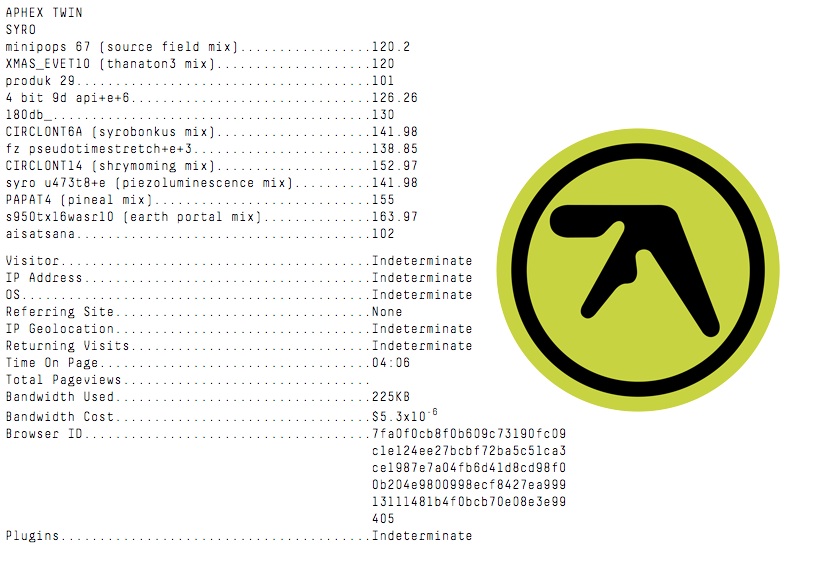


Aphex Twin’s Syro Blurs the Lines of High and Low Culture
Richard D. James is at Home Between the Profane and the Profound
by KYLE FLECK
Aphex Twin’s Syro Blurs the Lines of High and Low Culture
APHEX TWIN Richard D. James’s influence on the past two decades of music (and handsome ponytails) is difficult to overstate.
1. minipops 67 (source field mix) 4:47
2. XMAS_EVET10 (thanaton3 mix) 10:31
3. produk 29 5:03
4. 4 bit 9d api+e+6 4:28
5. 180db 3:11
6. CIRCLONT6A (syrobonkus mix) 6:00
7. fz pseudotimestretch+e+3 0:58
8. CIRCLONT14 (shrymoming mix) 7:21
9. syro u473t8+e (piezoluminescence mix) 6:32
10. PAPAT4 (pineal mix) 4:18
11. “950tx16wasr10 (earth portal mix) 6:01
12. aisatsana 5:21
Total length: 64:31
For the 1984 film Amadeus, Tom Hulce got an Oscar nomination for playing Mozart, and his portrayal is a stunningly idiosyncratic take on the legendary composer. Instead of trotting out some tired “tortured genius” shtick, Hulce donned an outsize white wig and hammed it up hard, playing Mozart as a giggling man-child, equally at home making fart jokes as he was effortlessly penning the most gorgeous melodies known to man. His professional rival, Antonio Salieri, is slowly driven mad by jealousy of Mozart’s talents, asking God how he could bestow “the gift” on such a lewd and lowly cretin.
There’s an uneasy fascination that comes from grappling with the idea that both sides—the unhinged bacchanalia of the id and the celestially sensitive composer—could exist simultaneously in the same man. And if there’s one present-day artist who embodies this stark juxtaposition, it would have to be Richard D. James, the godfather of modern electronic music, also known as Aphex Twin.
Not to make any grandiose statements (because really, trotting out Mozart references these days is a slippery slope) but the music released by James during his peerless ’90s run taps into the play between scatterbrained juvenilia and unearthly beauty like no artist before or since. From acid-tinged breakbeat workouts to warped “pop” songs about the milkman’s wife, nothing was off-limits to James, who used orchestral samples, chopped-up ‘ardcore beats, and homemade synthesizers to craft stunningly original, avant-garde “dance” music. There were no boundaries between high and low culture to the Twin, whose tunes were influenced just as much by Philip Glass and Brian Eno as they were by pirate radio and raves.
And James’s influence upon music for the past two decades is difficult to overstate. He’s been name-dropped as an inspiration by everyone from Björk to Outkast’s Andre 3000 to Skrillex, not to mention Thom Yorke, who essentially changed the entire course of Radiohead’s trajectory upon discovering Aphex Twin. If you have only a glancing knowledge of electronic music, you may be most familiar with his work from a pair of diabolically twisted music videos released at the tail end of the ’90s: “Come to Daddy” and “Windowlicker.” The former was a send-up of death metal, the latter a contorted mainstream rap parody—the iconic videos plastered James’s face on everybody from demonic children to bosom-heavy, bikini-clad beach bunnies. There was a satisfying mental disconnect seeing these frankly terrifying clips on normcore MTV, sandwiched between Jay Z and the Chili Peppers.
Then, since the release of 2001’s divisive double album Drukqs: silence. A series of low-key analog-worshipping EPs under other monikers have come out in the intervening years, but no new Aphex Twin material aside from bootlegs of live gigs, pored over lovingly by die-hards online. Until a month ago, that is, when a blimp appeared above London, emblazoned with the Aphex Twin insignia. And just like that, the dry spell was over. A new album, called Syro, was released last week.
What this record makes clear right out of the gate is that Aphex Twin doesn’t give a toss about your chart-topping EDM, or your bro-step, or even your postmodern outsider techno. This music exists outside of and apart from trends, and remains as hermetically sealed in James’s singular sonic universe as it always was—a demented and detuned fun-house mirror of techno’s past and present. Despite this stubborn insularity, the album comes off as one of his most open and accessible, delivering a crowd-pleasing set of futurist electro, alien acid, and mutated machine-prog.
Early favorites are easily found: The pointillist mid-tempo techno of first single and opener “minipops 67 [120.2] [source field mix]” ends in a gloriously weird duet between warped vocals and clipped breakbeats, a sort of love-struck cousin to “Windowlicker”‘s libidinous G-funk. “PAPAT4 [155] [pineal mix]” is an unabashedly gorgeous throwback to some sort of idyllic forest-nymph rave, with a chopped drum line and pulsating, woozy synth chords wafting obliviously above the fray. And the epic “XMAS_EVET10 [120] [thanaton3 mix]” is already being spoken of in the same breath as the best Aphex tracks, a shape-shifting 10-minute ride through discordant pianos, shuffling dance beats, and some of the most athletically stretchy acid bass ever put to tape. Though it lacks the gobsmacking WTF moments of James’s classic material, Syro trades the rabid experimentation of those early years for an imposing mastery of song craft and dynamics, showcasing a jazzily intuitive sense of instrumental interplay and forward-thinking composition.
After the manically splattered jungle of “s950tx16wasr10 [163.97] [earth portal mix],” the album finally closes on a strikingly simple non sequitur—a plangent, minimalist piano composition evoking French avant-garde composer Erik Satie. Even in this seemingly sincere and unadorned ballad, though, James can’t help himself: He sticks a sample of birdsong in the background, a sly wink to the most clichéd of all new age tropes, a subtle “fuck you” to the whole idea of the weepy album closer. Even now, with the resurrection of his most revered persona, James uses his “gift” purely for his own enjoyment. The rest of us are happy to get glimpses in the meantime.
